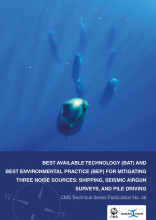Best Available Technology (BAT) and Best Environmental Practice (BEP) for Mitigating Three Noise Sources: Shipping, Seismic Airgun Surveys, and Pile Driving - Technical Series No. 46
Noise pollution is known to cause significant disturbance to marine wildlife, including migratory species protected under CMS such as whales and dolphins (and their prey). Such impacts can result in adverse changes to entire marine ecosystems.
Animals exposed to elevated or prolonged anthropogenic noise can suffer direct injury and temporary or permanent auditory threshold shifts, compromising their communication and ability to detect threats and find food, sometimes leading to death. Anthropogenic noise can displace wild animals from critical habitats, including from their migration routes, and mask important natural sounds, such as the call of a mate.
This CMS Technical Series report focuses on three major sources of noise pollution: shipping, seismic airgun surveys (used in oil and gas exploration) and pile driving (used for offshore wind farms and other marine infrastructure). It provides, for the first time, practical guidance on the Best Available Technology (BAT) and Best Environmental Practice (BEP) to reduce noise from these activities.
OceanCare prepared the report for CMS.

| Author(s) | Dr Lindy Weilgart |
|---|---|
| Published Date | June 2023 |
| Publication Language | English |
| Publisher | CMS Secretariat |
| Type | Technical Reports Technical Series |
| CMS Instrument | CMS |
COVID-19 & MIGRATORY SPECIES
Facts and Information about the Coronavirus Disease (COVID-19) and Wildlife. Learn more


